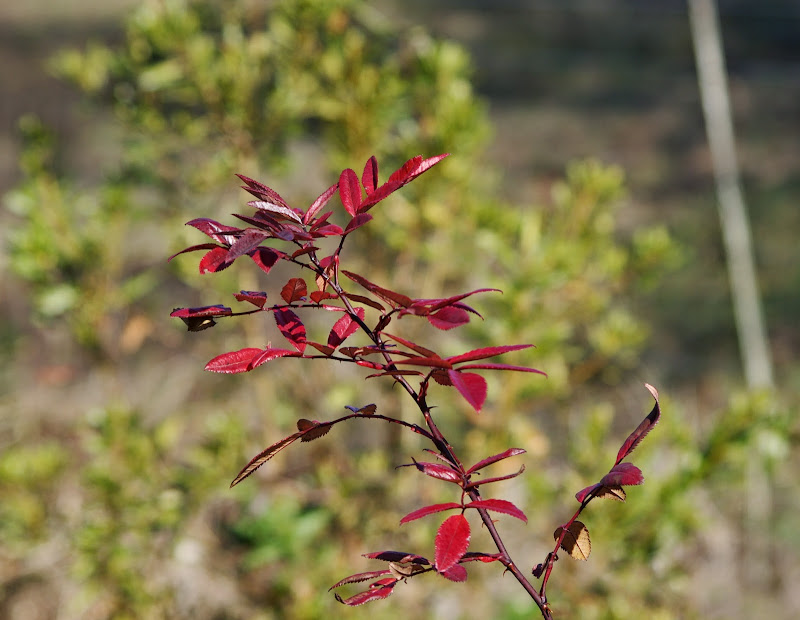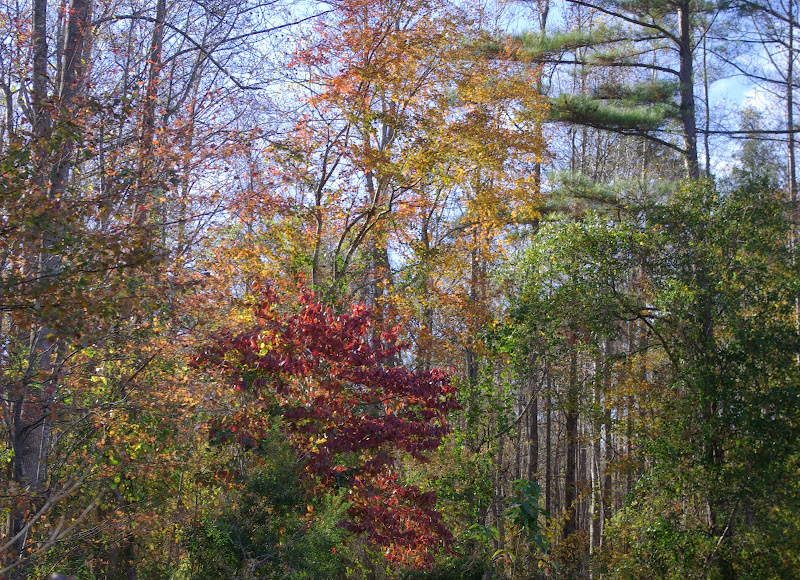As many people have noted, this fall was a beautiful one. And a very good year for the color red.
Naturally most of the leaves are on the ground now but I am still marvelling over this year's color.
*
Unless otherwise noted the pictures are from early and mid November.*
The only good quality I can find in poison ivy is its fall color.
October 28th

I know that red maples that turn red in fall aren't that uncommon: after all they abound in parking lots, they are featured on blogs and I've even seen the odd wild mature maple whose pure red perfection put the cultivars to shame (here anyway --
Laurrie's red maples in Connecticut are gorgeous), which is why I haven't just bought a cultivar.
But they don't abound on this farm. The only pure scarlet or crimson maples I have seen here are saplings, and it appeared they either outgrew this trait or were eventually outcompeted. (After all, I saw a half a dozen tiny willow oak sprigs yesterday that were red, but the only color I've ever seen willow oaks turn is brown, or, in a very wet year, gold.)
In the small pond that is my farm a red maple that turns red in fall had sort of become my white whale.
This year I saw not one but many.
This maple shone like a beacon in the woods.

Red maple at the edge of one of the floodway fields

There are a few small beautiful red maples underneath the tulip poplars above the house, bright spots among the tangle of Chinese privet and greenbriar that dominate half of the understory. This fall I have been making inroads into the privet and will burn the branches that have fruit. I also plan to take cuttings of the most colorful red maples next year, grow them up, and plant them in here. Already the tulip poplars are dying off and will need successors.
I don't recall this red maple turning such a brilliant shade of any color before, much less red.

The blueberry that started my obsession with the genus
Vaccinium is half hidden in the woods behind the electric tape paddock. Even though the trees around it have grown considerably since we first saw it, it still manages to color well. Most of my young blueberries were started from cuttings from this one. Nine to 12 inch cuttings taken in March, even before the limbs have budded out, have worked best.
Most musclewoods turn a vivid yellow or orange or a combination of both, but there is the occasional red. Not a fire engine red mind you, but, well, almost
pink.
The tree above wasn't the only one with pink tones. Some of the yellow ones did too.

In fact, I have never noticed so much pink in the fall colors as I have this year.
The sweetgums, usually a combo of red, yellow. orange and purple, had a pinkish glow this year.

Pink sourwood along a path in the woods

Virginia sweetspire typically turn many colors -- yellow, orange, red and purple -- but this combination of purple and pink is unusual.
The blueberry below looked almost florescent pink/red when the light was just right. It colored early for a blueberry and at its peak was spectacular even though it's small still. I marked it with pink tape so I can propagate from it next year. This fall rekindled my interest in plants with fall color and I've been tagging all sorts of things to propagate from next year, including the Va. sweetspire above.
Nov. 3rd

Nov. 12th

Water tupelos turn bright red, but I don't always see the ones in the slough by
the creek. This year I made a point to go down there to see the crimson tupelos.

There are young water tupelos up here too, in the ditches: one behind the big bed pictured
in the last post, and a small tupelo in the ditch beside the drive, near the house.
American beautyberry, winged sumac and water tupelo.

Water tupelo behind the big bed and Southern black blueberry. The blueberry was moved from the
old backyard about 9 years ago, when it was about 6 inches high. It's been very happy in its new spot.

Apricot red maple with the same blueberry and Miss Bessie on
Nov. 10th. This blueberry's fall leaves had amazing staying power.

On Dec. 1st, still fire engine red.

Sorrel trees and blueberries beside drive. Most of the blueberries here are black
highbush blueberries, but there is a Southern highbush blueberry beside the drive too.

A blueberry in the floodway field with the pond.

The brilliant blueberry near the dogwood isn't the only blueberry around. There are several beneath the poplars trees and at the edge of the woods. The small tree to the right is a young swamp chestnut oak, which starts out bright red but usually turns brown at the first freeze. Still, the leaves retains a certain richness of color and when the sun filters through them they still appear dark red.
In a
previous post I lamented not having the perfect sorrel tree. I still don't, but I found something close at the edge of the woods next to the old house site.
See the red sorrel tree back behind the yellow pepperbush and the burgundy blueberry? It doesn't appear to get enough sun to bloom, but it turned a almost perfect bright red. Before this year I didn't even know there was a sorrel tree back there.
The dogwood has never looked so beautiful. I hope the young ones end up as nice as this one.
The trees with pink tape are seedlings that I planted. I mark them to make sure I won't cut
them down while trimming around them. There are dogwoods, redbuds, and a sorrel tree here.

When I walked down to the creek to look for possamhaw berries for the Christmas wreath, I was disappointed to see no berries at all. The trees are too shaded now, and there's too much competition from (that damned) Chinese privet. Then, bam! I saw this possamhaw loaded with fruit right by the pond.
The encore azaleas often turn a deep plummy color when the weather turns cold, but this year they turned red.
I've managed to get one small stand of meadow beauty (
Rhexia virginica) going in front of the big bed. It was as beautiful in November as it was during the summer. I moved several divisions of meadow beauty into the garden and collected seed to start more. Pale meadow beauty (
Rhexia mariana, also known as Maryland meadow beauty) grows here too. Pale meadow has flowers that vary from medium pink to almost white, with thinner stems and leaves than
R. virginica. I noticed individuals of both species that were very colorful this fall.
This year wasn't just a good year for fall color, but for the garden as well. Last year I didn't like the garden until September, when all of the Bidens bloomed. This year I liked it much more. Two good years of rainfall have helped. Even more importantly, a change in medication has gotten the fibro under better control. I still have to count out my tasks for the day, dread cold fronts and some days really struggle to get/keep going, but the situation is improved over what it was.












































































